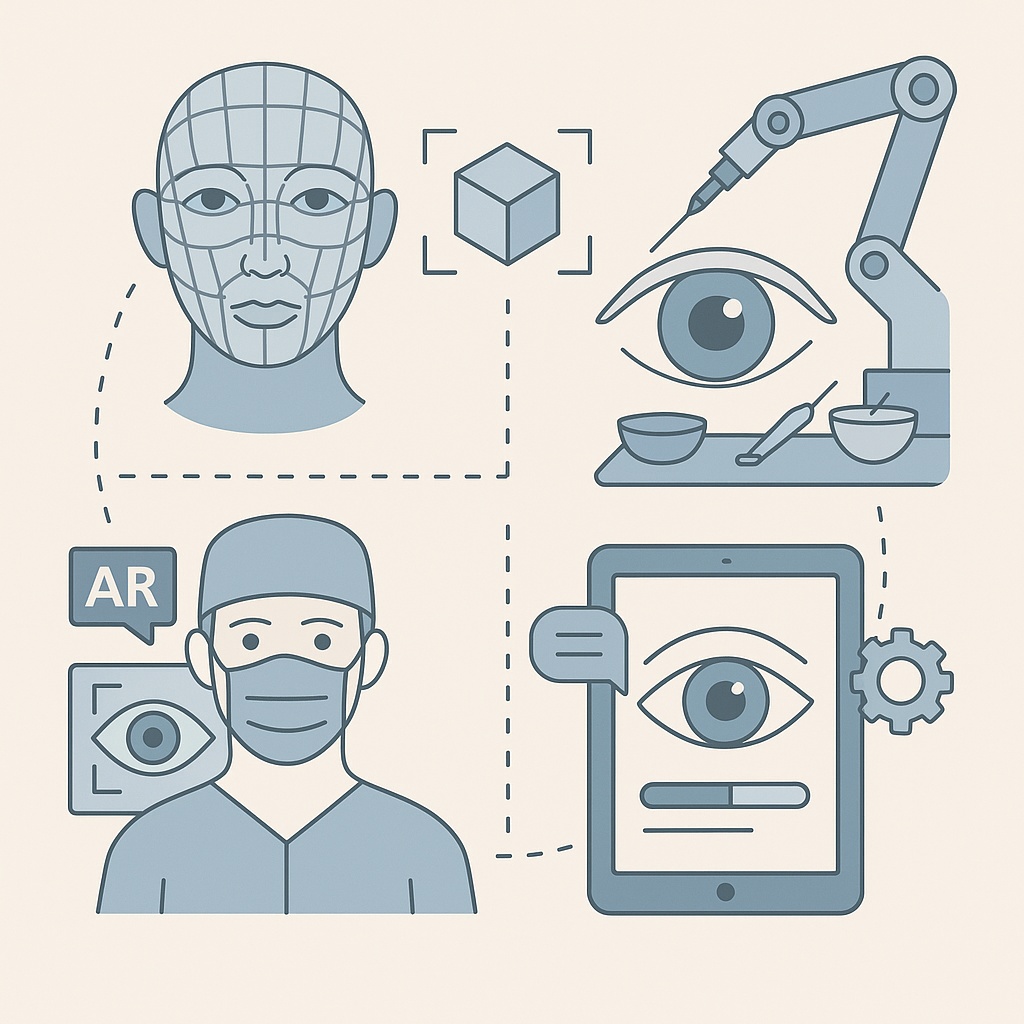Eye Surgery Technology 2025: Korea’s Leadership & Innovations
August 2, 2025 | by thecloudnexus.com


1. Pre-Surgery: AI, 3D Imaging, and Simulation
The digital patient journey begins long before the scalpel touches skin. Clinics now use multi-angle 3D photography systems that generate accurate digital facial meshes in real-time. These scans measure eyelid thickness, orbital angles, and skin elasticity down to 0.05 mm, helping surgeons design truly personalized procedures.
Next, AI-powered simulation tools project surgical outcomes using deep-learning models. Patients can adjust crease heights, fold angles, and eyelid openness using sliders, viewing their post-surgery appearance before making a decision. Clinics that implement this tech see conversion rates jump by over 40% compared to those relying solely on verbal consultation.
But planning goes beyond just visuals. Machine learning tools also map optimal incision points based on symmetry, skin tension, and suture positioning. The result? Lower revision rates and higher confidence—for both patient and surgeon.
2. In the Operating Room: Precision Tools and Augmented Guidance
Inside the OR, technology ensures that every millimeter counts. Surgeons now use augmented reality (AR) headsets that project incision maps directly onto the patient’s face. These overlays guide hand movement, ensuring better symmetry and faster execution, especially during double eyelid and ptosis correction surgeries.
Robotics, while still surgeon-assisted, play a key support role. From laser-guided tissue dissection to micro-forceps with pressure sensors, machines enhance the stability and accuracy of complex steps. High-resolution stereoscopic cameras help magnify tissues up to 25 times, reducing risks in delicate structures.
Energy-based devices—like plasma pens and fractional CO₂ lasers—are replacing traditional scalpels. These tools cause less thermal damage, speed up healing, and reduce bruising. Each laser pulse is digitally tracked and recorded, helping meet regulatory standards and improving traceability.
Korea is also one of the first countries where robotic accessories like motion-compensated injectors and AI-driven lid retractors are being piloted in high-volume clinics.
3. Post-Surgery Care: AR Instructions and Remote Monitoring
Recovery is just as important as surgery—and digital tools are transforming this phase too. Mobile AR apps now guide patients through real-time post-op routines: how to apply cold compresses, clean sutures, and perform gentle massages. These apps send personalized reminders synced with calendar apps and wearable devices.
Clinics also offer tele-monitoring systems using smartphone video uploads. AI compares daily images to baseline scans and flags concerning changes, such as excessive swelling, redness, or asymmetry. Surgeons or nurses receive alerts, allowing for remote intervention without clinic visits.
This not only saves time for patients but also reduces unnecessary in-person follow-ups by up to 40%, according to Seoul-based clinics.
And to ensure trust, clinics store before-and-after photos securely using blockchain-backed systems. Every image and laser log is hashed and time-stamped, giving patients full transparency and legal proof of what was performed.
4. Why Korea Leads the Global Eye Surgery Tech Wave
Korea isn’t just a participant in the global blepharoplasty market—it’s a driver. With over 900 aesthetic clinics in Gangnam alone, the country functions as a high-throughput innovation lab for new eye surgery technologies.
Here’s why Korea stands out:
- Fast Adoption: Korean manufacturers like WonTech and Lutronic roll out energy-based devices years before they reach Europe or the U.S.
- Data-Driven Surgery: AI labs from top hospitals (e.g., Yonsei and SNUH) partner with aesthetic clinics to co-develop tools trained on real-world surgical data.
- Medical Tourism Magnet: Clinics like DA PRS Semi-Incision offer multi-language care, 3D simulation, and even bundled recovery hotels, making Seoul a destination for patients across Asia and the Middle East.
- Aesthetic Authority: Korean eyelid styles—from parallel double eyelids to smooth medial epicanthoplasty—set trends that ripple across global markets.
In short, South Korea doesn’t just follow eye surgery tech trends—it sets them.
Conclusion: Technology isn’t optional—it’s essential
If you’re considering eye surgery (눈성형) in 2025, you’re not just choosing a surgeon. You’re choosing a technology ecosystem. Clinics that integrate 3D facial mapping, AI planning, AR-guided procedures, and tele-monitored recovery offer safer, faster, and more natural-looking outcomes.
And nowhere is this integration more complete than in Korea. Whether you’re a surgeon looking to upgrade your workflow, or a patient researching where to trust your face, understanding today’s digital tools will help you make better, smarter decisions.
Eye surgery technology is no longer a luxury. It’s the new standard.
RELATED POSTS
View all

